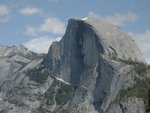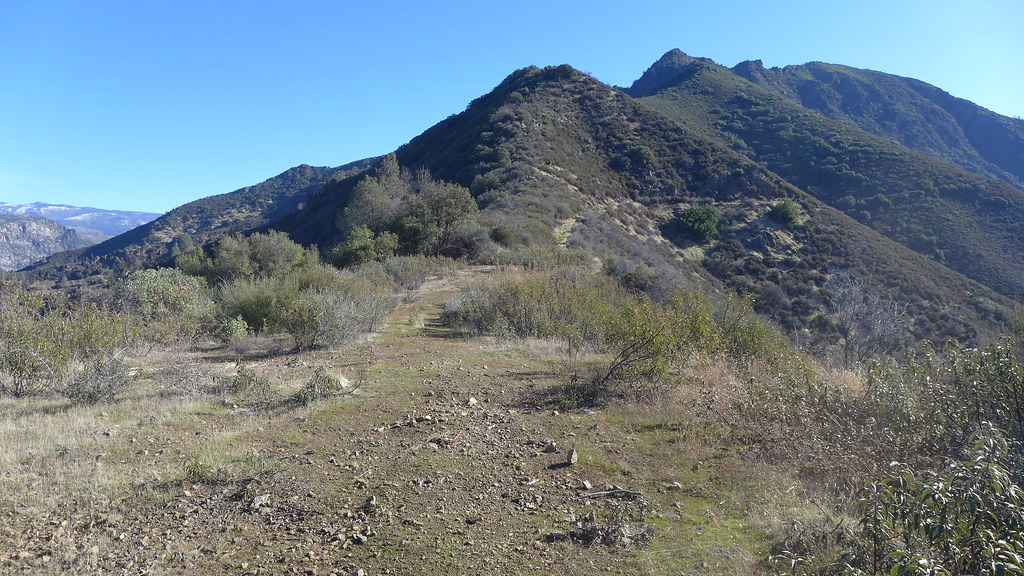On the drive to our trailhead, we stopped to look down on the fog that we had been in not too long ago.
Instead of starting at the official Bishop Creek trailhead, we did a short cross-country bushwhack from the Wawona Road that had been the subject of a previous boundary marker search. When we did hit the trail, it was very faint despite being on so many maps.
Although there had been signs of previous logging here and there, one tree seemed to have been cut down solely to provide a way to cross a side stream.
Between occasional flagging tape and a fairly well-trod path, the trail seemed to get some use. We dropped down to the first junction (with the Rush Creek/Iron Creek trail), which was unsigned.
From this unsigned junction, the trail climbed a bit to go over a spur. At the top of the spur, we lost the trail. Worse, the area was quite brushy and infested with poison oak. We knew where the trail generally went and headed down the ridge, crossed a stream, thrashed around some more brush, and headed for a low saddle where the trail would have to be again.
We were making slow progress, and were considering turning back, but halfway down the next hill, we encountered a substantially-built portion of the trail. It clearly hadn't been maintained in years, but it at least had once been a real trail. We followed this to the next stream, where we found an old sign for "Grapevine Camp".
The trail disappeared past Grapevine, but at the top of a nearly-dry waterfall, we could see the trail continuing around a grassy, mostly open hillside. At this point we were more or less committed to heading all the way to Savage's Trading Post.
The well-built trail stayed generally high above the river, and we could usually trace its route along the canyon wall ahead of us.
Below us, the river was a series of cascades, water slides, and the occasional waterfall.
Unfortunately the trail did occasionally pass through areas with more brush, shrub, and poison oak to dodge.
Fortunately, these sections were not too long, and were punctuated with open sections that allowed us to make decent progress.
At one point the trail dropped down to the river level near a nice rocky section--or, at least we thought it was the trail. While we did find some barbed wire here, we were not on the main trail and had to climb up a steep slope to get back on it. It had been nice to be near the river for a few moments, however.
The trail was quite narrow in the open sections, and the side-hilling was a bit tedious. And, despite the fact we were heading down river, we were doing a fair amount of climbing and dropping as the trail navigated the intricate terrain of the canyon.
We didn't (and still don't) know the history of the trail, but it's clear that someone once put a lot of effort into constructing it. Other than being overgrown in places, it is still in good shape and with some maintenance could be returned to good form.
The temperature was quite mild, and the still-yellow grasses were more reminiscent of late spring or summer and not the middle of winter.
Apparently the Great Pink One was not checking our progress--he didn't want to know how little progress we were making. There were enough obstacles that we could not maintain a clear-trail pace, and the short winter days meant that darkness was not too many hours away.
We lost some time looking for where the trail continued across a side stream. We found a small camp here, and curiously a few empty oil bottles. It was doubtful any motor vehicle could have gotten here. Perhaps the oil was for chain saws from long-gone--and very missed--maintenance crews?
At another side stream we refilled on water, then stopped for a quick lunch. We also called JKW and changed our pick-up time from 5:00 to "at least 6:00". We had brought three slices of pizza and a lot of other treats, but after splitting a single slice, we continued along--we knew we were racing the sun, and it was winning.
Eventually the trail dropped to river level again at Peachtree Bar, where we ended up on a rock with several mortar holes.
There seemed to be good camping here, and a nice open meadow a bit down river, but we rushed right through this place. The river was already in shadows.
The first river crossing, marked by a simple "Trail" sign with an arrow, was knee-deep, and brisk enough that the water made my trekking poles vibrate. The under-water rocks were round and slippery.
Despite how warm the day had seemed, the water was still cold and reminded us it was winter. My feet were freezing cold by the time I reached the other side, but they warmed up once I took off my water shoes and dried my feet. On each side of the river were two halves of a now-useless cable, although we couldn't figure out how it would have helped us cross the river even intact.
We were now on the south side of the canyon--in the dark, and also in much more lush forest. Poison oak shoots were everywhere. At Snyder Gulch was another mysterious cable; fortunately this side stream could be crossed with a careful rock-hop.
After a bit of a navigational goof, we were at the next junction--this one with a sign. Despite it being almost 5:00, we still had 9 miles to go.
Hite Cove was 4.5 miles away, not 2.
It was impossible to avoid the poison oak shoots in the lush forest the trail wandered though, and it continued to climb up and down, into and out of side gullies. The damp conditions made the trail quite slippery, which limited our progress. Eventually, almost in the dark, we saw another small sign. We were now on the Hite Cove "road."
We were still a few miles from Hite (or rather "Hites"
 Cove, but our path would in theory be much easier from here to Savages. Once on the road, our pace picked up, and we split some apple strudel.
Cove, but our path would in theory be much easier from here to Savages. Once on the road, our pace picked up, and we split some apple strudel.We called JKW again at a marked campsite and advanced our pick up time to 7:30. The final obstacle for us was the second river crossing. We had hoped to be at this crossing before sunset, but it was pitch dark when we arrived at Hite Cove. We stayed on the road until the west end of Hite Cove, where one map suggested the road crossed the river, but there didn't seem to be a safe way across here, so we backtracked to the east end, where the river was wide, calm--and dark. We had no way to gage how deep it was with our headlamps, and after I had my water shoes on, the Pink One was in water well over his waist--but he was mostly to the other side. I quickly followed. The unofficial depth gage was that the water was over the top of his trekking poles.
(A week later, we would revisit this crossing and learn that we crossed maybe 25' too far upstream of a much more shallow area.)
After putting back on dry shoes, we continued walking--we needed to keep moving to stay warm. We had a few false starts locating the trail that leaves Hite Cove, but it was obvious once we were on it.
A bit past the cove we passed some equipment from an old mill and took a few pictures.
From here the trail was mostly easy to follow with our headlamps, and not too much later we were at a reflective sign that indicated we had 3/4 miles to go.
Not far past this sign we saw the lights from the homes and lodgings at Savage's. JKW was on the radio, and she informed us that a warm car and warmer motel room awaited us. After two long showers to clean off any possible poison oak, we had a nice dinner.
Despite the long day and the chilly water crossings, I enjoyed the hike. And, although I had now officially been to Hite Cove, it's like I barely saw it. Another visit would be warranted.
The next day, the Great Pink One and I found two additional boundary markers--the highest numbered ones. He had to return to the Bay Area that day, but on Monday while looking for signs of old trails in the valley I stumbled across 10 unknown (to us) sequoias; a week later, the total would be over 40.
Overall, a very enjoyable weekend, even if we didn't backpack to the top of El Capitan.













